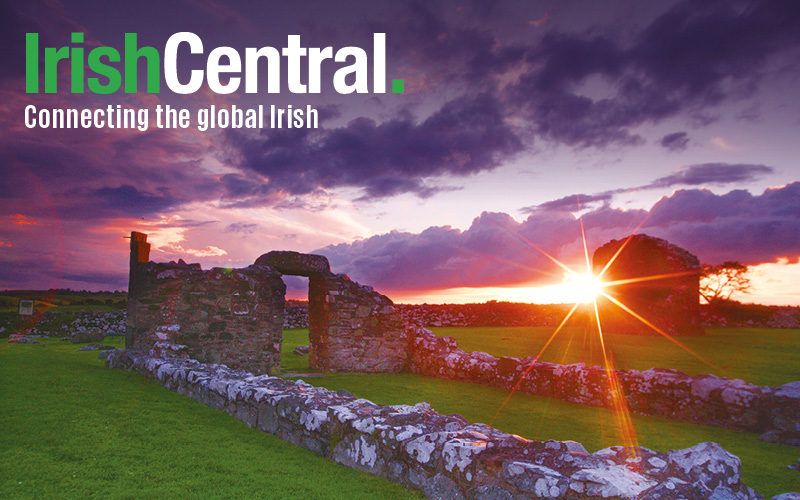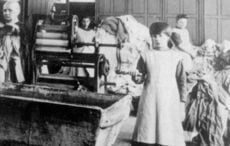'Stories from Leinster' offers a glimpse into the book about Saint Patrick's life.
'Saint Patrick: Life Legend and Legacy' by Marian Broderick was released by O'Brien Press in March 2019.
Read More: The classic Irish book you simply must read during March
Drawing from recorded histories, 'tall tales' from all four provinces, and beautiful illustrations, this is a light-hearted look at the global phenomenon of Saint Patrick, his life and his legacy, the facts and the fiction of his incredible journey from slave to an international saint.
Below, enjoy an excerpt from 'Saint Patrick: Life Legend and Legacy' entitled 'Stories from Leinster':
VALLEY OF THE KINGS: STORIES FROM LEINSTER
It is logical to assume that the adult Patrick made first landfall on the island of Ireland around 432. According to the earliest biographers, this happened on the east coast near the mouth of the River Boyne, or further south where Wicklow now stands (though current thinking is that County Down in the northeast was a more likely landing place). Leinster is a landscape rich in pagan culture with standing stones, henges, and sacred waters. There is a wealth of archaeology in the valley of the Boyne, including ancient graves, and the famous hill of Tara was once the power base of the High King of Ireland. Further afield, the age-old custom of the Lughnasa fire festival can still be witnessed at Uisneach, the sacred centre of pre-Christian Ireland.
Read More: Don't believe these myths about the Irish
INVER DÉ, COUNTY WICKLOW
This is where both Muirchú and Tírechán claim Patrick disembarked at the very beginning of his mission. According to the Leabhar Breac, he found a great welcome from a local chieftain. A little boy in the house became so devoted to Patrick that he begged to travel with him on his journey. So his family agreed, and the boy, Benignus, went on to be the first native Irishman to become a bishop.
WICKLOW, COUNTY WICKLOW
An alternative legend claims that when Patrick first attempted to land in Wicklow near the estuary of the River Vartry, warlike locals repelled him and smashed the teeth of one of his followers, giving the place its ancient Irish name Cill Mhantáin or Church of the Toothless One. However, this incident is more likely to have happened to Palladius, Patrick’s predecessor (see Pack of Pats, page 19), since he is recorded as having had a hostile reception when first in Ireland.
DID YOU KNOW?
During the nineteenth century, Queen Victoria banned her Irish regiments from wearing the shamrock anywhere on their uniform.
The plant had become associated with constitutional nationalism, of which she was not a fan. But after heavy losses in Irish regiments during the Boer War, she changed her mind.
SHAM SHAMROCK?
One of the most famous stories about Patrick is how he picked a three-leaved shamrock to explain his religion. But today’s plant is not the same as the one Patrick knew. The early edible plant was trefoil wood sorrel, a native to Ireland. Nowadays this native plant has been replaced by another clover – inedible this time – that has been in Ireland since the sixteenth century. It is said that Patrick used the famous three leaves on one stalk to explain the Christian idea of the Trinity – Father, Son and Holy Spirit – the three parts making up one God. However the first mention of Patrick’s link with the shamrock wasn’t until 1727!
Read More: Everything you know about the St. Patrick's Day shamrock is a lie
THE HILL OF UISNEACH, COUNTY WESTMEATH
Near to Ballymore, Uisneach packs a lot into a relatively small hill. Archaeology shows it had been a ritual site for the burning of sacred fires since Neolithic times. The turn of the seasons and the life-giving sun were celebrated here, along with pagan deities, such as Eriu, who gave her name to Ireland.
It was the site of the great festival of Bealtaine, when a massive ritual fire was lit that could be seen for miles around. Here too Lughnasa, the harvest festival, was celebrated at the end of August. The god who gave his name to this festival, the famous Lugh of the Long Arm, ruled from here and died here. Another
The Hill of Uisneach still hosts the pre-Christian festivals of Bealtaine and Lughnasa legend says that the god Nemhedh fought and banished the giant Formorians from here.
Before Tara, Uisneach was the seat of the high kings. Great royal assemblies were held here. In Brehon times, these were not optional party invitations. A cattle fine would be imposed on those who failed to turn up wearing their best clothes and jewels. The king would use the assemblies to make judgements in cases of land dispute, and offer lavish hospitality to vassals, in return for their continuing loyalty.
Read More: Summer solstice 2018 celebrated at Hill of Tara and around the country
Located at the centre of Meath (Midhe, the ‘middle’ fifth province of Ireland), Uisneach also marks the exact centre of Ireland, the ‘navel of the land’ – though how ancient people would have sensed this is not clear. The area is covered with fascinating ancient features including forts, cairns, earthworks, and even an ancient chariot road connecting east and west. There is an enormous boulder known as the Catstone (Aill na Míreann) where the goddess Eriu is said to be buried.
Uisneach’s current signage reads:
- Site of Celtic festival of Bealtaine [celebrated 1 May]
- Ancient place of assembly
- St Patrick’s Church
- Sacred centre of Ireland in pagan times
- Site of druidic fire cult
- Seat of high kings
Small wonder then that Patrick headed for this sacred place to found a church. It was not plain sailing: he was repelled by the dominant clan at the time, the O’Neills, and he placed a curse on the stones of Uisneach.
The site also features in a work first written down from older oral sources in the thirteenth century called the Colloquy with the Ancients (Agallamh na Seanórach). This is part of the Fenian cycle of myths from pre-Christian times, in which Caoílte, a giant warrior of Fionn mac Cumhaill’s Fianna, meets with Patrick and the King of Ireland and tells them the legends of the past.
There is a St Patrick’s Bed at Uisneach, which is a stone that marks the spot where Brigid met Patrick. There is also a St Patrick’s Church and a St Patrick’s Well.
Read More: Ireland's ancient holy wells of Saint Patrick
BRIGID: SLAVE, GODDESS, PRIEST, AND NUN
Brigid, one of Ireland’s most loved saints, is a semi-historical figure based, in part, on an older pagan goddess of the same name.
The goddess Brigid was the daughter of the Dagda, king of the gods. The pagan Irish called upon her help to heal the sick and comfort the dying, and also to look after the all-important livestock. Her feast day in early February was known as Imbolc and it celebrated the moment when the winter gave way to the first promise of spring.
The historical St Brigid has melded with this earlier goddess figure. Tradition says that her father, Dubhthach, was a druid (or a chieftain in some versions), and her mother, Broicsech, his slave. Young Brigid grew up in Faughart, County Louth, where her charity, healing and miracles made her famous.
One story says that Brigid took holy orders from Patrick at Uisneach. During the vows, Patrick used the form of words reserved for priests, not nuns. When it was pointed out to him he said, ‘Let it stand’, recognising perhaps that she was a formidable personality. Indeed she went on to become the foremost Christian leader in Leinster, and is credited with converting many women, including important pagan princesses.
Read More: Everything you need to know about St. Brigid ahead of St. Brigid's Day 2019
Tradition says that Brigid remained such a friend to Patrick that they were called the ‘twin pillars’ of the early church. Patrick and his successors knew well what they were doing; the people who had always loved the goddess Brigid and called on her help were able to continue to do so in her new guise of St Brigid.
St Brigid travelled widely and founded a number of religious houses, much bigger at the time than any monastery run by men. There are a number of overlaps between the saint and the goddess. The saint’s most famous convent, housing both men and women at Kildare, was on a pagan site previously devoted to the goddess (Cill Dara means Church of the Oak Tree, a pre-Christian sacred tree). Another overlap may relate to her symbol, St Brigid’s cross. Do the spokes radiating from the centre represent the pagan sun turned into a Christian symbol? Finally St Brigid’s feast day is celebrated on 1 February – at the same time as Imbolc, the festival of her pagan namesake.
Read More: How is St. Brigid connected with the great Celtic goddess?
PATRICK AND THE ASSASSIN OF KILDARE
The Tripartite Life says that as Patrick passed through Kildare, he escaped an assassination attempt due to the loyalty of Odhran, his charioteer.
Failge Berraide, one of the pagan lords of the area, had boasted that if he met Patrick he would kill him, in revenge for the overthrow of the idol Crom Cruaich, which had been specially venerated by Failge. His murderous boast was concealed from Patrick by his people, but when they all came into Failge’s district, Odhran the charioteer took matters into his own hands.
Said Odhran to the saint, ‘Since I have been a long time driving for you, Patrick, let me take the chief seat for this day, and you be the charioteer.’ Patrick consented, and changed positions with Odhran. After this Failge came up and stabbed Odhran, believing him to be Patrick. In one version of this story, Patrick curses Failge but Odhran begs Patrick with his dying breath to place the curse instead on a tree sacred to Failge’s clan. This Patrick did and Odhran, at the moment of his death, forgave his murderer, becoming the only martyr in Patrick’s time.
SKERRIES, COUNTY DUBLIN
This ‘rocky place’ on the east coast has a group of three uninhabited islands, Inishpatrick, Colt Island and Red Island, which are linked with Patrick.
According to Tírechán, Inishpatrick (St Patrick’s Island) was visited by Patrick when he first came back to Ireland. A story relates how one day, while he was out preaching, the mainlanders came to Inishpatrick and stole his goat, which they cooked and ate. When Patrick came after the thieves, he jumped from Inishpatrick onto Red Island where his footprint can still be seen to this day. A local tradition is to put three fingers into the water in the footprint and make a wish.
Another story says that Inishpatrick was where he stopped overnight when sailing north from Wicklow to Down to see his old master.
Read More: The truth about St. Patrick's life from kidnapping to Irish Catholicism
ST PATRICK’S CATHEDRAL, DUBLIN CITY
This beautiful Church of Ireland cathedral is one of the largest churches in Ireland. It is medieval, but was founded on the site of a pre-Christian spring, in which Patrick baptised converts around 450.
A slab can still be seen from that time, featuring an early Celtic cross, which was used to cover the sacred well.
The Order of St Patrick, whose regalia can be seen hanging around the cathedral, is a dormant chivalric order, that is, a social club for knights of the realm. Chivalric orders were created by monarchs all over Europe and this one was started by George III in 1783 to prop up the Protestant Ascendancy, and give the wealthy a reason to dress up. The insignia, a type of jewelled badge, was so ornate it was also known as the Irish Crown Jewels. It was stolen from Dublin Castle just before a royal visit in 1907, and never seen again.
Read More: Top Irish history books to delve into this St. Patrick’s Day
Text by Marian Broderick. Thanks to O'Brien Press for sharing this excerpt with IrishCentral. You can pick up a copy of the book here.
Looking for Irish book recommendations or to meet with others who share your love for Irish literature and writers? Be sure to join to IrishCentral Book Club here and enjoy our book-loving community.




Comments